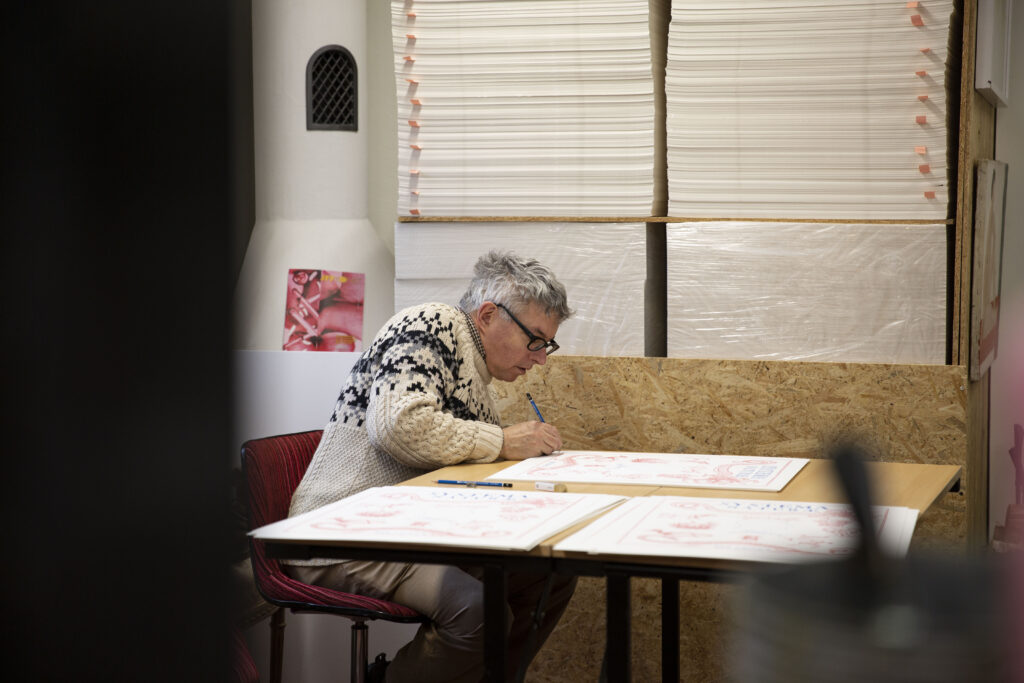
“A crossroad of science and folk culture, where they must part ways”
Svenska/English
The artist Mark Dion, living in New York, is current with a new artwork in our Fine Art Print shop. A critical approach to the view of natural history and how dominant ideologies categorize animals and plants form the core of Dion’s artistry. He has exhibited around the world, including at the Tate Gallery in London and the Museum of Modern Art in New York. We sat down with Dion during the signing of the new lithograph at Lumpé lithographic, produced in collaboration with Saskia Neuman Gallery.
Text: Anna Henriksson
The creatures in “Paradoxa, 2023” was deemed unfit for Carl von Linné volumes of flora and fauna, when did you become familiar with these creatures? What fascinated you?
– Linné is one of the superstars in the history of natural history. Over the years, I have read so much about Carl Von Linne and long ago I came across the mention of Paradoxa. It was such a curious notion, I knew somehow I had to make a work about it. The 1735 first printing of “Systema Naturae”was a mere elven pages long, but in those pages, Linné takes the time to describe a handful of things, which most naturalist of the period seemed to believe, but he was not so sure. The heading Paradoxa and descriptions does not again appear in any of the expanded later editions of the book (I think there are thirteen), which makes it all the more intriguing. So, in a way Linné is putting to rest the era of fantastic speculative thought in the naturalist tradition by stating his skepticism about mythic beasts. The notion of the Paradoxa represents a crossroad of science and folk culture, where they must part ways.
In your practice you investigate the history of natural history, scientific history and methodology. What are your thoughts about museum collections, selection, the memories and stories they embody? How can a collection today become a place for open dialogue?
– Museums are a technology of knowledge that have been around for quite some time now. Collecting is a technologically of knowledge as well, and one which has been around for much longer, certainly longer then written language. It is one of the ways we learn to understand our environment. For some people collecting is something like a passion of even a compulsion. I guess what draws me to the topic of collecting is my affinity to things, to materiality. After all I am a sculptor, someone who makes meaning with things. Since museum are often culturally sanctioned spaces, sometimes agents of the state, they seem to tell the “official story”; they speak with authority. Natural History Museums, for example, are mandated to define the natural world for a particular group of people at a distinct time. However, we know that the notion of nature is a highly contentious one, an idea always in flux, a battleground of ideas. The collections are often the chess pieces in the battle.
The status of objects in the collection is in dialog with shifting cultural values. For example, today many would feel quite differently about hunting trophies in a museum. Once an emblem of courage, virility and dominance over nature, many would understand them today as cruel, toxic and unnecessary.
You have been devoted to printmaking a long time, how would you describe the way you work with printmaking and in what way are prints/printmaking essential for your work?
– While I have never been a gifted technical printer, I have been involved in printmaking since 1982, when I took my first print making classes at art school. There are two things I love about printmaking, the first being the social aspect of printmaking. While it is possible to make a print alone, it is much better to do it with other people. The print studio is a social space, very different from stereotypical lonely artist studio, where one makes work in isolation. Conversation and dialogue never stop in the print shops I have worked in. The second aspect of print is the idea of the multiple, the edition; that there are more than one work produced. For me this implies generosity with the art objects. Gifting works to friends, contributing to benefits, keeping the price low, means that prints find their way into the hands of people love them, rather than just those who can afford them.